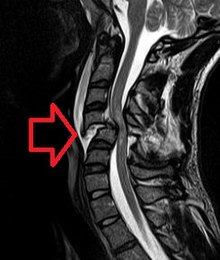User:Mr. Ibrahem/Spinal cord injury
Template:Good article is only for Wikipedia:Good articles.
| Spinal cord injury | |
|---|---|
| Other names | Spinal trauma |
 | |
| MRI of fractured and dislocated neck vertebra that is compressing the spinal cord | |
| Specialty | Neurosurgery |
| Symptoms | Weakness, numbness, autonomic dysfunction, pain[1] |
| Complications | Pressure sores, infections, deep vein thrombosis, autonomic dysreflexia, breathing problems[2] |
| Types | Complete, incomplete[3] |
| Causes | Physical trauma, infection, insufficient blood flow, toxins, tumors[2][4] |
| Diagnostic method | Based on symptoms, medical imaging[3] |
| Prevention | Improvements to motor vehicles, gun control, violence prevention[2] |
| Treatment | Spinal motion restriction, intravenous fluids, vasopressors[3] |
| Prognosis | Decreased life expectancy[5] |
| Frequency | 250,000 and 500,000 per year[2] |
Spinal cord injury (SCI) is damage to the spinal cord that causes temporary or permanent problems.[1] Symptoms may include loss of muscle, sensation, or autonomic function.[1] Bowel or bladder incontinence, sexual dysfunction, and pain may also occur.[1] Injury can be complete, with a total loss of function at lower levels, or incomplete, meaning some nervous signals are able pass the injured area.[1] Complications can include pressure sores, infections, deep vein thrombosis, autonomic dysreflexia, and breathing problems.[2]
The majority of cases in the United States result from physical trauma such as car accidents (38%), falls (30%), violence such as gunshot wounds (13%), or sports injuries (9%); but can also result from nontraumatic causes such as infection, insufficient blood flow, toxins, or tumors.[2][4] Just over half of injuries affect the neck, while 15% occur in the thoracic spine, border between the thoracic and lumbar spine, and the lumbar spine alone.[3] Diagnosis is typically based on symptoms and medical imaging.[3]
Efforts to prevent these injuries include improvements to motor vehicles, gun control, and violence prevention.[2] Treatment starts with restricting further motion of the spine and maintaining adequate blood pressure.[3] Corticosteroids have not been found to be useful.[3] Other interventions vary depending on the extent of the injury, from bed rest to surgery.[6] Long-term physical and occupational therapy are also helpful.[2] Outcomes range from full recovery to permanent paralysis of much of the body.[1]
Globally, between 250,000 and 500,000 are affected a year.[2] In the United States, about 17,000 people survive a spinal cord injury a year.[5] Those most commonly affected are young adult males.[5] It typically results in a significantly shorter life expectancy.[5] Research into potential treatments includes stem cell implantation, spinal stimulation, and wearable robotic exoskeletons.[7]
References[edit]
- ^ a b c d e f "Spinal Cord Injury Information Page | National Institute of Neurological Disorders and Stroke". www.ninds.nih.gov. Archived from the original on 13 January 2022. Retrieved 12 February 2022.
- ^ a b c d e f g h i Bennett, Joe; M Das, Joe; Emmady, Prabhu D. (2022). "Spinal Cord Injuries". StatPearls. StatPearls Publishing. Archived from the original on 12 February 2022. Retrieved 12 February 2022.
- ^ a b c d e f g ATLS – Advanced Trauma Life Support – Student Course Manual (10th ed.). American College of Surgeons. 2018. pp. 129–144. ISBN 9780996826235.
- ^ a b "Overview of Spinal Cord Disorders - Brain, Spinal Cord, and Nerve Disorders". Merck Manuals Consumer Version. Archived from the original on 30 October 2021. Retrieved 12 February 2022.
- ^ a b c d "Spinal Cord Injury (SCI) 2016 Facts and Figures at a Glance". The journal of spinal cord medicine. 39 (4): 493–4. July 2016. doi:10.1080/10790268.2016.1210925. PMID 27471859.
- ^ "Spinal Trauma - Injuries; Poisoning". Merck Manuals Professional Edition. Archived from the original on 5 February 2022. Retrieved 12 February 2022.
- ^ Krucoff MO, Miller JP, Saxena T, Bellamkonda R, Rahimpour S, Harward SC, Lad SP, Turner DA (January 2019). "Toward Functional Restoration of the Central Nervous System: A Review of Translational Neuroscience Principles". Neurosurgery. 84 (1): 30–40. doi:10.1093/neuros/nyy128. PMC 6292792. PMID 29800461.
